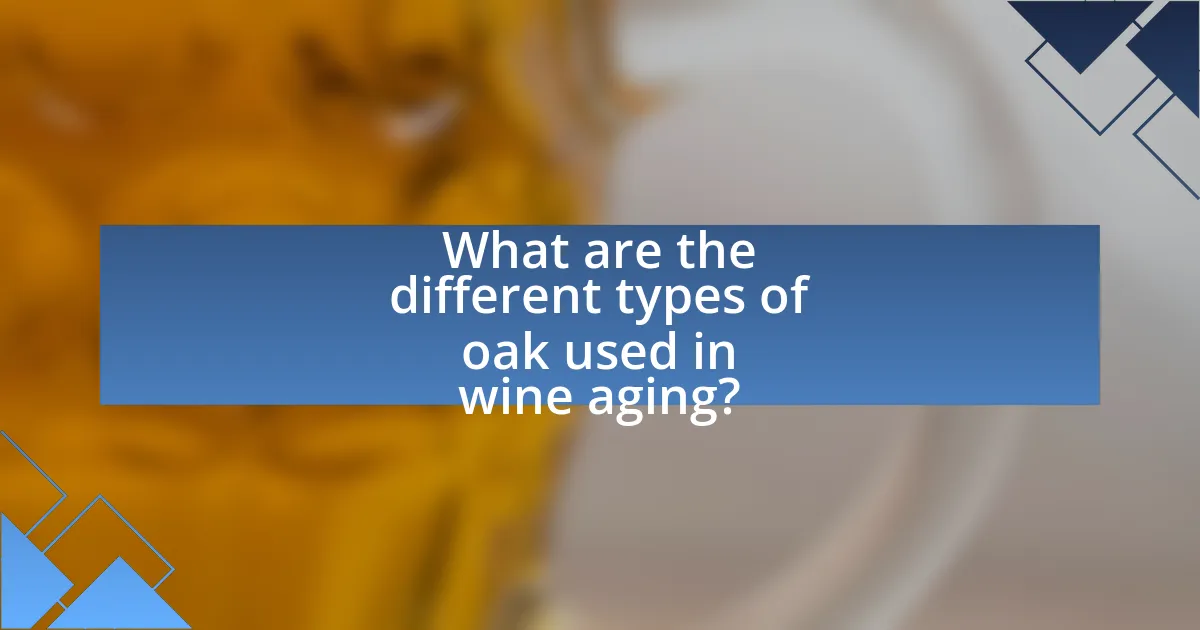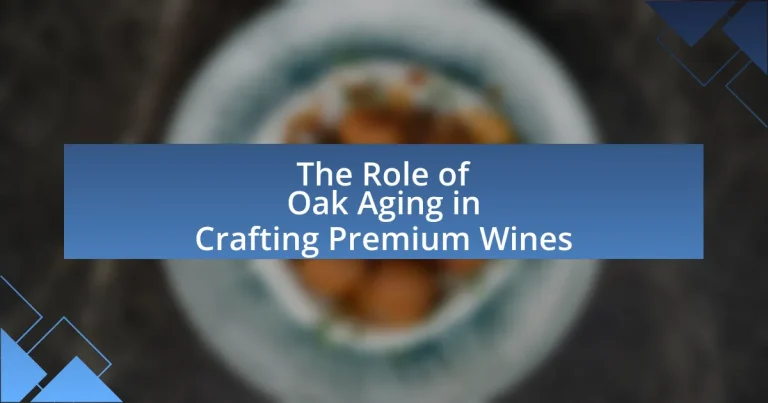Oak aging is a fundamental process in the production of premium wines, significantly enhancing their flavor complexity, aroma, and texture. The interaction between wine and oak barrels introduces compounds such as vanillin and tannins, resulting in desirable notes of vanilla, spice, and toast. Different types of oak, including American, French, and Hungarian, impart unique flavor profiles, while the toasting level of barrels affects the wine’s characteristics. This article explores the role of oak aging in winemaking, detailing its influence on flavor profiles, the historical practices surrounding it, and the differences between premium and standard wines. Additionally, it examines the maintenance of oak barrels and practical tips for winemakers to optimize the aging process.

What is the Role of Oak Aging in Crafting Premium Wines?
Oak aging plays a crucial role in crafting premium wines by enhancing flavor complexity, adding aromas, and improving texture. The interaction between wine and oak barrels allows for the infusion of compounds such as vanillin, tannins, and lactones, which contribute to the wine’s overall profile. Studies indicate that wines aged in oak can exhibit notes of vanilla, spice, and toast, which are highly sought after in premium varieties. Additionally, oak aging promotes micro-oxygenation, which softens tannins and stabilizes color, resulting in a smoother mouthfeel. This process is essential for developing the depth and character that define high-quality wines.
How does oak aging influence the flavor profile of wines?
Oak aging significantly influences the flavor profile of wines by imparting complex flavors and aromas. The interaction between wine and oak barrels introduces notes such as vanilla, spice, and toast, which enhance the overall sensory experience. Research indicates that compounds like vanillin, which is released from the wood, contribute to these flavors, while the porous nature of oak allows for micro-oxygenation, softening tannins and adding depth. Studies have shown that wines aged in oak can exhibit a more rounded mouthfeel and greater complexity compared to those aged in stainless steel or other materials.
What specific flavors are imparted by different types of oak?
Different types of oak impart distinct flavors to wines, significantly influencing their profiles. American oak typically contributes flavors of vanilla, coconut, and caramel due to its higher lactone content. French oak, on the other hand, offers more subtle notes of spice, clove, and a creamy texture, attributed to its tighter grain and lower lactone levels. Hungarian oak combines characteristics of both, providing flavors of chocolate and spice. These flavor profiles are a result of the oak’s chemical composition and the toasting process, which caramelizes the wood sugars and enhances flavor extraction during aging.
How does the toasting level of oak barrels affect wine characteristics?
The toasting level of oak barrels significantly influences wine characteristics by altering the flavor profile, aroma, and texture of the wine. Higher toasting levels typically enhance the extraction of vanillin, which imparts vanilla notes, while also contributing to caramel and spice flavors. Conversely, lighter toasting levels may preserve more of the wine’s original fruit characteristics and acidity. Research indicates that the toasting process also affects the tannin structure, with medium toasting often resulting in a smoother mouthfeel due to the breakdown of harsher tannins. Studies have shown that wines aged in heavily toasted barrels can exhibit a more complex flavor profile, with a balance of oak influence and fruit expression, which is crucial for premium wine crafting.
Why is oak aging considered essential for premium wines?
Oak aging is considered essential for premium wines because it enhances flavor complexity and contributes to the wine’s overall structure. The interaction between the wine and the oak barrel allows for the infusion of desirable compounds such as vanillin, tannins, and various aromatic compounds, which can add notes of spice, vanilla, and toast. Additionally, the porous nature of oak facilitates micro-oxygenation, which softens tannins and promotes a smoother mouthfeel. Studies have shown that wines aged in oak barrels often receive higher ratings from critics, indicating a preference for the depth and character that oak aging imparts.
What are the historical practices surrounding oak aging in winemaking?
Historical practices surrounding oak aging in winemaking involve the use of oak barrels to enhance the flavor, aroma, and texture of wines. Dating back to ancient civilizations, such as the Romans and Greeks, winemakers utilized oak for fermentation and storage, recognizing its ability to impart desirable characteristics to the wine. The practice became more refined in the Middle Ages, particularly in France, where specific types of oak, like Quercus robur, were favored for their tight grain and flavor contributions. By the 17th century, the use of oak barrels became standard in Bordeaux and Burgundy, leading to the development of distinct regional styles. The interaction between wine and wood during aging allows for the extraction of tannins, vanillin, and other compounds, which enhance complexity and mouthfeel, solidifying oak aging as a critical component in crafting premium wines.
How does oak aging differentiate premium wines from standard wines?
Oak aging differentiates premium wines from standard wines primarily through the complexity and depth of flavors it imparts. Premium wines often undergo longer aging in high-quality oak barrels, which enhances their aromatic profile with notes of vanilla, spice, and toasted wood, while also contributing to a smoother mouthfeel. In contrast, standard wines typically use shorter aging periods or stainless steel, resulting in simpler flavor profiles that lack the richness and complexity found in premium varieties. Studies have shown that wines aged in oak can develop more nuanced characteristics, making them more desirable among connoisseurs and collectors.

What are the different types of oak used in wine aging?
The different types of oak used in wine aging include American oak, French oak, and Hungarian oak. American oak, known for its strong vanilla and coconut flavors, is often used for aging bold wines like Zinfandel and Cabernet Sauvignon. French oak, prized for its subtle spice and toast characteristics, is commonly utilized for aging fine wines such as Chardonnay and Pinot Noir. Hungarian oak, which offers a balance between the characteristics of American and French oak, is increasingly being used for various wine styles. Each type of oak contributes distinct flavor profiles and tannin structures, influencing the overall complexity and quality of the wine.
What are the characteristics of American oak versus French oak?
American oak is characterized by its pronounced vanilla and coconut flavors, while French oak offers more subtle spice and floral notes. The differences arise from the wood’s grain structure and chemical composition; American oak has a wider grain, allowing for greater oxygen exposure and faster extraction of flavors, which results in a bolder profile. In contrast, French oak has a tighter grain, leading to slower flavor integration and a more nuanced taste. Studies indicate that American oak typically imparts stronger tannins and a sweeter profile, whereas French oak contributes a creamier mouthfeel and complexity, making each type suitable for different wine styles.
How do the grain and tannin levels differ between American and French oak?
American oak has a coarser grain and higher tannin levels compared to French oak, which has a finer grain and lower tannin content. The coarser grain of American oak allows for a more pronounced extraction of flavors and tannins, resulting in bolder, sweeter notes in wines. In contrast, the finer grain of French oak leads to a more subtle integration of flavors and a smoother mouthfeel, contributing to a more elegant profile in wines. This difference in grain and tannin levels significantly influences the aging process and the overall character of the wine.
What impact does the origin of the oak have on wine flavor?
The origin of the oak significantly impacts wine flavor by influencing the chemical compounds released during aging. Different oak species, such as American, French, and Eastern European oak, impart distinct flavors and aromas to the wine. For instance, American oak typically contributes stronger vanilla and coconut notes due to higher levels of lactones, while French oak is known for subtler spice and floral characteristics due to its tighter grain and lower lactone content. Studies have shown that the toasting process of the oak barrels also varies by region, affecting the flavor profile; lighter toasting can enhance fruitiness, while heavier toasting can add smokiness and caramel notes. This variation in flavor contribution based on oak origin is crucial for winemakers aiming to achieve specific taste profiles in their wines.
What are the alternative woods used in wine aging?
Alternative woods used in wine aging include cherry, chestnut, acacia, and hickory. These woods can impart unique flavors and characteristics to the wine, similar to oak. For instance, cherry wood can add a fruity note, while chestnut may contribute a more tannic structure. Acacia is known for enhancing floral and fruity aromas, and hickory can introduce a smoky quality. The use of these alternative woods is supported by winemakers seeking to diversify flavor profiles and enhance the complexity of their wines.
How do these alternative woods compare to traditional oak in flavor contribution?
Alternative woods, such as cherry, maple, and chestnut, contribute different flavor profiles compared to traditional oak, which is known for its vanilla, caramel, and spice notes. Cherry wood imparts a fruity and slightly sweet flavor, while maple adds a subtle sweetness with hints of caramel. Chestnut offers a more tannic structure and earthy notes. Research indicates that the chemical compounds in these woods, such as lactones and phenolic compounds, vary significantly from those found in oak, leading to distinct flavor contributions in wine. For instance, a study published in the Journal of Agricultural and Food Chemistry highlights that the flavor compounds released during aging differ based on the wood type, confirming that alternative woods can enhance or alter the sensory experience of wine compared to traditional oak.
What are the benefits and drawbacks of using alternative woods?
The benefits of using alternative woods include cost-effectiveness, sustainability, and unique flavor profiles that can enhance wine characteristics. For instance, woods like cherry or acacia can impart different aromatic qualities compared to traditional oak, allowing winemakers to experiment with diverse sensory experiences. Additionally, alternative woods often come from faster-growing species, which can reduce environmental impact and promote sustainable forestry practices.
However, the drawbacks of using alternative woods involve potential inconsistency in flavor and aging characteristics, as these woods may not have the same chemical properties as oak. This inconsistency can lead to unpredictable results in wine quality. Furthermore, the lack of established aging practices with alternative woods means that winemakers may face challenges in achieving desired outcomes, as there is less historical data to guide their use in wine production.

How does the oak aging process work in winemaking?
The oak aging process in winemaking involves storing wine in oak barrels, which imparts unique flavors and characteristics to the wine. During this aging, compounds from the wood, such as tannins, vanillin, and lactones, are extracted, enhancing the wine’s complexity and mouthfeel. Additionally, the porous nature of oak allows for micro-oxygenation, which softens tannins and promotes the development of aromas. Studies have shown that wines aged in oak can exhibit notes of vanilla, spice, and toast, contributing to their premium quality.
What are the steps involved in the oak aging process?
The oak aging process involves several key steps: selection of oak barrels, preparation of the barrels, filling the barrels with wine, aging the wine, and finally, bottling the wine.
First, winemakers select specific types of oak, such as French or American oak, based on the desired flavor profile. Next, the barrels are prepared, which may include toasting the interior to enhance flavor extraction. After preparation, the barrels are filled with wine, allowing the wine to interact with the wood. During the aging phase, which can last from several months to years, the wine absorbs compounds from the oak, such as tannins and vanillin, which contribute to its complexity and character. Finally, the wine is bottled after the aging period, ready for consumption.
This process is essential in crafting premium wines, as it significantly influences the wine’s aroma, flavor, and overall quality.
How long should wine be aged in oak barrels for optimal results?
Wine should typically be aged in oak barrels for a duration of 12 to 24 months for optimal results. This aging period allows the wine to absorb desirable compounds from the oak, such as tannins and vanillin, which enhance flavor complexity and mouthfeel. Research indicates that red wines often benefit from longer aging, while white wines may achieve optimal results with shorter aging times, generally around 6 to 12 months. The specific aging duration can vary based on the wine variety and desired characteristics, but the 12 to 24-month range is widely recognized in the wine industry as effective for developing premium quality wines.
What factors influence the aging duration in oak barrels?
The aging duration in oak barrels is influenced by several key factors, including the type of oak used, the level of toasting, the size of the barrel, and environmental conditions such as temperature and humidity. Different oak species, such as American or French oak, impart distinct flavors and tannins, affecting the aging process. The level of toasting, which caramelizes the wood sugars, can enhance flavor complexity and influence how quickly compounds are extracted into the wine. Additionally, smaller barrels have a higher surface area-to-volume ratio, leading to faster aging compared to larger barrels. Environmental factors, such as temperature fluctuations and humidity levels, also play a critical role in the interaction between the wine and the wood, impacting the overall aging duration.
What are the common practices for maintaining oak barrels?
Common practices for maintaining oak barrels include regular cleaning, proper storage conditions, and periodic inspection. Cleaning involves rinsing the barrels with hot water and using a soft brush to remove residues, ensuring that no wine or bacteria remains that could spoil future contents. Proper storage conditions require keeping barrels in a cool, humid environment to prevent drying and cracking, which can compromise the wood’s integrity. Periodic inspection allows for the identification of leaks or damage, enabling timely repairs or replacements. These practices are essential for preserving the quality of the wine and extending the lifespan of the barrels, as studies show that well-maintained barrels can last for decades while imparting desirable flavors to the wine.
How does barrel maintenance affect the quality of the wine?
Barrel maintenance significantly affects the quality of wine by ensuring optimal conditions for aging and flavor development. Proper maintenance, including regular cleaning and monitoring of barrel integrity, prevents spoilage and contamination, which can lead to off-flavors. For instance, the presence of unwanted microorganisms can compromise the wine’s taste and aroma. Additionally, maintaining the right level of toasting and managing the barrel’s oxygen exposure enhances the extraction of desirable compounds, such as tannins and vanillin, which contribute to the wine’s complexity. Studies have shown that well-maintained barrels can improve the overall sensory profile of wine, leading to higher quality products.
What are the signs of barrel deterioration that winemakers should watch for?
Signs of barrel deterioration that winemakers should watch for include leaks, off-odors, and excessive char or toast breakdown. Leaks can lead to wine loss and oxidation, while off-odors, such as mustiness or vinegar-like scents, indicate microbial contamination or spoilage. Excessive breakdown of char or toast can result in undesirable flavors in the wine, affecting its quality. Monitoring these signs is crucial, as studies show that barrel integrity directly impacts the aging process and flavor profile of the wine.
What practical tips can winemakers follow for effective oak aging?
Winemakers can achieve effective oak aging by selecting the right type of oak, controlling the toasting level, and monitoring the aging duration. Choosing French or American oak can influence flavor profiles, as French oak typically imparts subtle spice and vanilla notes, while American oak offers bolder flavors like coconut and caramel. The toasting level, which ranges from light to heavy, affects the extraction of compounds such as tannins and vanillin, thus impacting the wine’s complexity. Additionally, winemakers should regularly taste the wine during the aging process to determine the optimal aging duration, as over-aging can lead to excessive oak influence, masking the wine’s inherent characteristics. These practices are supported by research indicating that oak aging significantly enhances the sensory attributes of wine, making it a crucial step in crafting premium wines.

